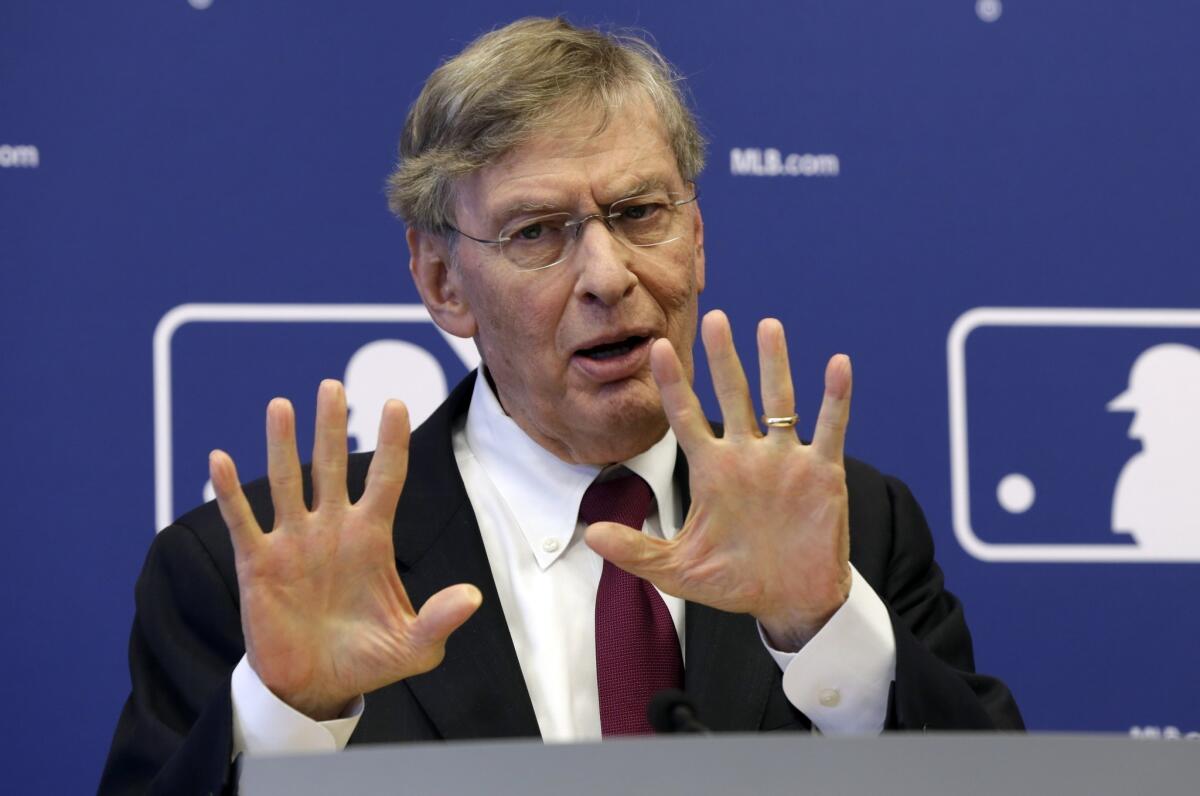Names of suspended players in latest MLB doping scandal might not be revealed

- Share via
In 2007, at the conclusion of baseball’s first multimillion-dollar investigation into steroids, Commissioner Bud Selig authorized publication of the Mitchell Report. The report ran 311 pages, including 96 pages of evidence linking 54 players, most of them for the first time, to performance-enhancing substances. The report also included 32 pages of supporting documents, including canceled checks and shipping receipts.
As baseball’s second multimillion-dollar investigation into performance-enhancing drugs approaches its conclusion, can we expect publication of a Biogenesis Report, laying out the evidence for what are expected to be mass suspensions?
Probably not, according to a person briefed on the investigation. Too many privacy concerns, he said.
But Selig is considering whether to announce the names of at least some of the suspended players before any appeal hearings could be held. He has the right to do so, for those players previously disciplined or publicly linked to drug use by a source other than the commissioner’s office. The essence of the argument: Who doesn’t know about Alex Rodriguez? Where is the privacy issue there?
The players’ union disagrees, saying that Selig’s right is intended to apply to names publicly revealed in governmental investigations and police reports, not in stories or investigative accounts by news organizations. A player could win an appeal but still be scarred with a scarlet letter S, for steroids.
“If it takes two years,” Detroit Tigers outfielder Torii Hunter said, “make sure the guys that are innocent stay innocent.”
Baseball’s drug policy frowns upon disclosure of evidence. Privacy concerns could become a bargaining chip.
Michael Weiner, the chief of the players’ union, talked last week about negotiating deals for a player who “deserves a suspension.” It is entirely possible that a player could agree to a shorter suspension if the commissioner’s office agrees not to reveal the evidence supporting a suspension, or if the player decides an appeal runs the risk of evidence leaking from the hearing.
Either way, that would eliminate the possibility of a comprehensive Biogenesis Report along the lines of the Mitchell Report. Not that we were likely to get one anyway, but transparency would breed confidence in Selig’s claim that his sport is “cleaner than it’s ever been.”
If you build it . . .
The Tampa Bay Rays played host to the World Series in dark and depressing Tropicana Field five years ago. Since then, Selig has lobbied for a new Rays ballpark. The only two teams without a new or renovated park: the Rays and the Oakland Athletics.
Selig said last week his patience is “running … thin” with the Tampa Bay ballpark situation. Of course, when the A’s proposed a San Jose ballpark, Selig told them to let him handle it. Four years later, San Jose’s patience has run so thin that the city has filed an antitrust suit against Major League Baseball, in the hope of spurring a decision.
Selig called the Rays’ attendance “very disappointing and very worrisome.” The Rays, on pace for their sixth consecutive winning season, rank next-to-last in the majors in attendance, with an average of 17,791.
“That may have been OK in 1956,” Selig said.
In 1956, as it turns out, only three of 16 clubs averaged 18,000 in attendance. The major league leader: Selig’s hometown Milwaukee Braves, at 26,576.
It was not until 1978 that the majority of clubs averaged 18,000, according to baseball-reference.com.
If you want disappointing and worrisome, try these statistics for Chicago White Sox average attendance:
1960, season: 21,357.
2013, first half: 21,937.
More to Read
Go beyond the scoreboard
Get the latest on L.A.'s teams in the daily Sports Report newsletter.
You may occasionally receive promotional content from the Los Angeles Times.











